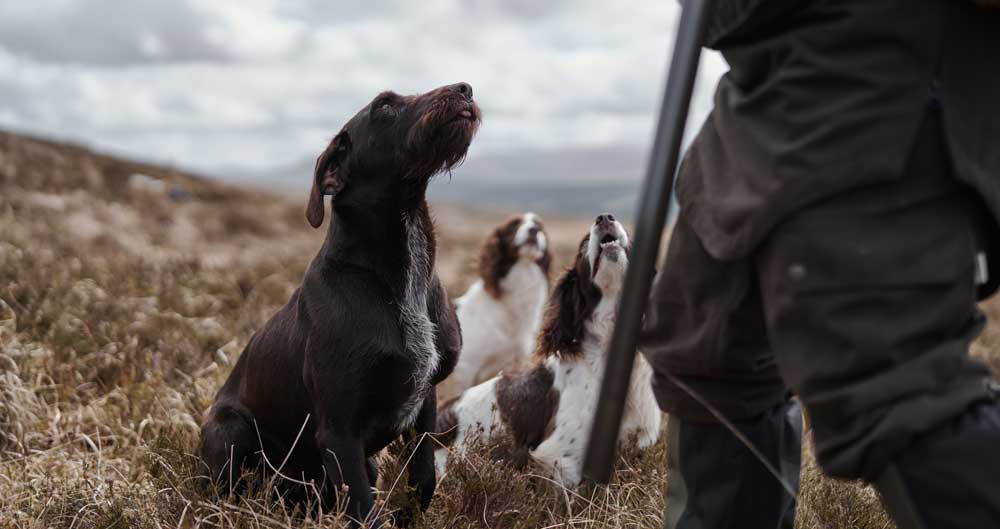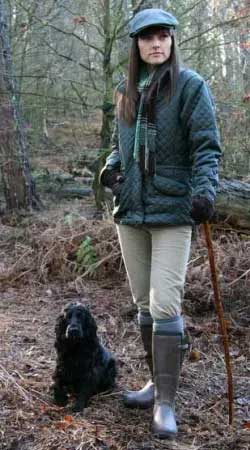Filter by Topic:
Posted by Bethan Bithell on Jan 31, 2024
What is Pheasant Beating?
Pheasant beating involves flushing out birds, using flags, whistles and dogs. Generally beaters walk in a line, move forward together flushing out game birds for shooters who are waiting on the hills. There can be a lot of standing around waiting in all weathers, so being prepared is a ‘must’ if you are to keep warm.
Whether you are new to pheasant beating or well versed with the sport, managing tough terrain can always be difficult. Brambles and thorns can cause havoc and sometimes ruin the whole day!
Beating for pheasants is a sport enjoyed by many. Being a pheasant beater is an important role and by working with other beaters and shooters, it can be a sociable occasion.
Apart from enjoying the fresh air and fabulous views, becoming a beater on a shoot has many other benefits. For example, due to the long hours and the amount of walking needed, beating is a fantastic way of getting some exercise plus meeting like-minded people.
What to Wear Pheasant Beating?
Knowing what to wear can sometimes be a bit tricky on your first outing. Is it leather boots or wellingtons, jeans or wax over-trousers? Read on for more guidance on the best footwear, and clothing to wear to get the most out of the experience.
Pheasant Beating Clothing
It goes without saying that waterproof jackets, trousers, or breeks, will keep you dry as you push your way through brambles, bushes, or wet grass. Also, consider that tweed clothing is ideal when beating, as it is both tough and waterproof.
Waistcoats are a great layer as they give you the warmth needed for your back, whilst giving plenty of movement in the arm area.
Wax jackets are also a great choice for beating, as these can be hosed down at the end of the day and they are less likely to tear when walking through rough ground! Avoid bright colours as neutral colours such as Olives and Browns will be considered acceptable by other beaters and shooters.
When selecting beating trousers, it's crucial to consider the terrain you'll be traversing. If you anticipate encountering brambles and thorns, opting for sturdy rip-stop beating trousers is essential. These trousers are fully waterproof and exceptionally durable, making them ideal for navigating challenging conditions.
The most effective way to keep warm when out on the field is to wear plenty of layers. Layers are recommended because they can be added or taken off, depending on the weather. These layers trap air and therefore keep you warm! Consider wearing thermal base layers for colder shoot days; these will help to keep you warm and wick away moisture preventing ‘catching a chill’.
When beating, it’s likely that your hands will be waving about in the air, so a good pair of warm, comfortable gloves will be a very good investment, particularly those with a good grip to hold on to your flags and beating stick. It may be worth considering a pair of waterproof gloves, with an extra glove liner, ideal for those extremely cold, uncomfortable days!
Another way you can avoid getting cold, when out in all elements, is to keep your head warm. Heat escapes through the top of the head, so a warm comfortable hat is really a necessity. A neck gaiter is also a great addition, in order to keep the neck area warm.
Beating Footwear
Due to the amount of time spent on your feet, it is recommended that a tough pair of leather shooting boots are worn. Leather boots are designed to offer support and comfort, whilst wellington boots can be cold and difficult to wear, and may even cause blisters! When out beating it's always best to wear leather boots with leg gaiters. The gaiters will give extra protection from thorns, heather and brambles. Wellingtons are fine if standing around on muddy ground, or walking through streams – but even then, you may still have cold feet so it may be worth considering a good pair of neoprene lined wellies!
There are clear benefits of wearing leather boots that have sturdy sole units, an example of which is the Grisport leather boots. These fantastic boots will give you the extra support you need when walking on uneven, rocky terrain. Make sure that the boots are equipped with a Vibram sole unit. Such sole units are slip resistant. Check out our review of the Grisport Gamekeeper boot
Wearing Vibram sole boots for pheasant shooting can offer several benefits:
- Traction: Vibram soles are well-known for their exceptional traction, even in rugged and slippery terrain commonly encountered during outdoor activities like pheasant shooting. This can help prevent slips and falls, especially in wet or muddy conditions.
- Durability: Vibram soles are highly durable and designed to withstand heavy use over extended periods. This durability is advantageous for activities like pheasant shooting, where boots may be subjected to rough terrain and harsh environmental conditions.
- Comfort: Many Vibram sole boots are designed with comfort in mind, featuring cushioning and support technologies that can reduce fatigue during long days of walking and standing while shooting.
- Stability: The design of Vibram soles often includes features like lugs and grooves that provide stability and support, particularly on uneven or challenging terrain. This can enhance the beaters and shooter's balance and overall performance.
- Grip: Vibram soles are engineered to provide excellent grip on various surfaces, including wet grass, rocks, and mud, which are common in pheasant shooting environments. This enhances the beaters ability to move confidently and maintain stability while navigating diverse landscapes.
RELATED ARTICLE: Lacing Techniques that Can Help with Foot Problems

Beating Gaiters
When considering gaiters, it is necessary to think about the ease of putting them on and how tough they are. Due to the damage thorns can cause, it is suggested that wax gaiters or gaiters made from a tough polyester are worn. Wax gaiters and stronger gaiters can be stiff and awkward to wear sometimes and, if this is the case, you may want to consider a rip stop gaiter or overtrousers. These will give you similar protection – although may not actually be thorn proof!
Alternatively, wax leggings or trousers will give great protection. Wax leggings are easy to put on, pack small in a rucksack or game bag, and won’t restrict movement. These are thorn proof and you can re-wax them for added protection!
Socks for Beating
Equal attention should be paid to the choice of beating or shooting socks you opt for! For added warmth and comfort, it's advisable to wear loop-stitched socks. These socks, with minimal seams and a distinctive loop-stitched interior, offer a slight "bounce" while walking. Wearing stockings or knee-high socks can offer extra comfort, support, and ankle protection. Additionally, incorporating woolly and warm foot bed insoles can effectively shield your feet from dampness.
Beating is indeed a serious sport, but there’s nothing to stop you having a bit of fun with what you wear. Why not brighten up the mutual tones of the wax jacket and waistcoats with a pair of shooters pattern braces or a pheasant silk tie. Very snazzy! Plus don’t forget your hip flask to provide refreshment when and as required.
General Care Guides
To guarantee many years of enjoyment from your jacket, leggings and over trousers, don’t forget to dry them out properly after use and give them a bit of tender loving care with a re-proofing treatment once in a while. Actually the same applies to any leather boot – remember, brambles can be hard on leather!
Conclusion: Pheasant Beating Clothing and Footwear
Pheasant beating involves flushing out birds using flags, whistles, and dogs while walking in a line to drive game birds toward shooters. This activity demands endurance in all weather conditions. Proper attire is crucial, especially considering the challenging terrain, often filled with brambles and thorns.
The recommended attire includes layers for warmth, thermal baselayers for cold days, warm gloves with good grip, hats and neck gaiters for head warmth, waterproof jackets and trousers, wax clothing for toughness, and waistcoats for back warmth and arm movement. Sturdy leather boots with Vibram soles are advised for traction, durability, comfort, stability, and grip on various surfaces. Additionally, wax gaiters or rip-stop gaiters are recommended for thorn protection.
To recap, your essential beating kit should include:
- Leather beating boots – with a Vibram sole unit, if possible, for extra grip and comfort
- Wax or rip stop gaiters – to protect your ankle from thorns and brambles
- Chaps or over-trousers – wax is tough and thorn proof, and re-proofable
- Gloves – to keep your hands warm, especially when holding your flag
- Cosy, warm hat – to prevent the heat from escaping through the top of your head
- Wax or waterproof jacket, waistcoat and breeks – these are produced from tough and waterproof fabric
Click here to view our full range of Clothing, Footwear and Accessories for Pheasant Beaters
Important facts:Did you know that there are important restrictions in place, enforced by the Countryside Alliance. These include:England and Wales
No game may be killed on Sundays or Christmas Day and game may not be shot between one hour after sunset and one hour before sunrise!
For further restrictions on shooting game birds, wildfowl, Geese and Waders and Ground Game, Deer and Wild Boar, check out the Countryside Alliance website.
If you enjoyed this guide, or found it useful or helpful, then why not subscribe to our new future guides – be in the know! Subscribe here for our newsletter.
Last Modified: 31st Jan 2024
(Original 2nd Sept 2015)

